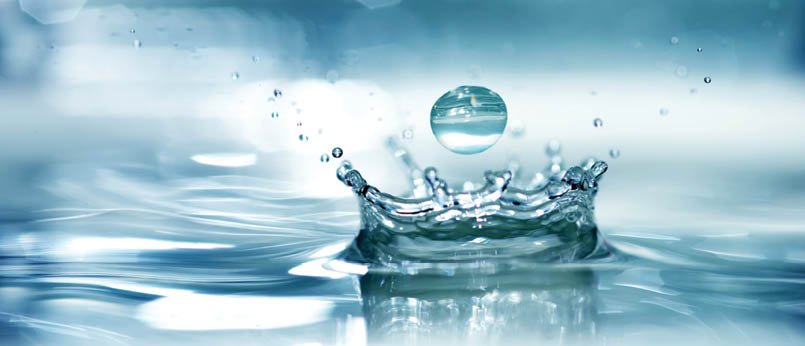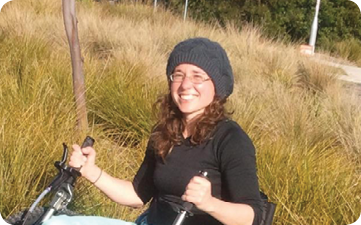

How much water is needed on bushwalks? This is one of the most contentious topics among bushwalkers, next to the shoe vs boot debate. Some of the debate comes from the difference in understanding between water intake verses actually drinking water. In this article we look at total water intake including from food. Other debate arises around how long your body can hold a water debt for, and here we look at maintaining optimum hydration levels.

Water Requirements on a Bushwalk
Helen Smith

58 | BWA October 2016



Incredibly, the human body is mostly water, about 50-70% for males and 40-60% for females. Hence, adults have 30-40 kilograms of water. A loss as small as 2% of this water may have serious effects on performance, so staying well hydrated is critical for feeling good and performing well on a bushwalk.
Water comes from fluids and eating foods with high water content such as fresh or tinned fruit. Water loss occurs through sweat, urination and respiration. Sweat increases when the body heats up in hotter and/or more humid conditions, and with more exertion. Sweat is the body’s cooling mechanism; sweat resting on the skin surface cools the skin. But it comes at a price: loss of body water, triggering thirst, and a desire to drink and replenish body water. Water loss due to sweat is far lower when resting in shade and when there’s more wind chill.
Wet bulb globe temperature (WBGT) is a “feels like” temperature based on actual temperature plus humidity, wind chill and shade. WBGT provides a more accurate indication of the temperature as perceived by humans. Probable WBGT can be used to plan which walk to do and how much water to carry.
US Army guidelines give a good indication of water needs, translating well to Australian bushwalks. Under spring conditions (WBGT
= 15-25°C), bushwalkers carrying a pack of under 10 kilograms require about half a litre of water for every hour of walking. So a typical four hour spring day walk means that two litres should be drunk. However, it only takes an increase of 5°C (WBGT) for the water requirement to increase by 50%. Under these conditions, bushwalkers require about three quarters of a litre of water for every hour of walking.
Once the WBGT exceeds 32°C, water requirements are about one litre per hour, and extended walking may become impractical. Under such conditions, walks should have ample supplies of reliable water at regular intervals, with distances and climbing shorter if at all possible. Another option is to walk during the cooler parts of the day.
Water BalancingGetting the water and salt intake balance rightKeeping well hydrated is a balancing act between drinking enough to stay hydrated but not so much that essential salts are too diluted. While both can lead to serious medical conditions, they’re easy enough to avoid with proper planning and awareness. Urine colour is a visual indication of hydration levels. In general, the better hydrated the body the lighter the urine colour.
“...bushwalkers carrying a pack of under 10 kilograms require half a litre of water for every hour of walking.
“... walks should have ample supplies of reliable water at regular intervals ...
WBGT
Feels like
Water needs
Notes
~15°C
Cool spring day
0.5 litre/hour
Great walking weather
~25°C
Warm spring day
0.5 litre/hour
Great walking weather
~28°C
Warm-hot summer day
0.5 litre/hour
Take a short rest every hour
~30°C
Hot summer day
0.75 litre/hour
Take several short rests every hour
~32°C
Very hot summer day
0.75 litre/hour
Rest 20 minutes for every 50 minutes of walking
>32°C
Extremely hot summer day
Minimum of 1 litre/hour
Physical activity should be kept to a minimum
BWA October 2016 | 59
The human body makes the best use of water when it is ingested in small amounts regularly, allowing time for water to be absorbed and used in the system. That’s why it’s important to drink regularly on a bushwalk. Hydration bladders make drinking small amounts regularly very easy. Some people struggle to drink enough water. If so, try lightly flavouring water with cordial or setting a drinking goal, perhaps marking “drink-to” points on the water bottle. Note that flavouring water will render this water and perhaps make the container unsuitable for meals or other drinks.
Caffeinated drinks like tea and coffee are mild diuretics, causing increased passing of urine. Drinking these can lead to dehydration if they’re drunk in large quantities or if the body isn’t used to them, but in small amounts such as on a bushwalk they provide similar hydrating qualities to water.
Soft drinks and energy drinks are less effective at hydrating than water due to the high sugar content. High sugar concentrations slow fluid absorption into the blood system. Some energy drinks also contain caffeine, guanine and preservatives which can even have negative effects on performance. Occasionally, people react badly to these kinds of drinks, so it's best to try these at home first, or better – just stick to water!
DehydrationDehydration affects physical performance and occurs when the body loses water faster than it is replenished. When the overall body water content drops by 2%, dehydration signs and symptoms occur.
Signs and symptoms of early dehydration 2% of water body mass loss include:
Flushed skin
Weariness
Sleepiness
Impatience
Moderate dehydration 4% of water body mass loss
Apathy
Muscle fatigue
Nausea
Severe dehydration 6% of water body mass loss
Headache
Dizziness
Shortness of breath
Tingling in limbs
Very dry mouth
If someone in the group has signs of dehydration, stop in a shade and administer first aid. Make sure that the patient responds to stimuli and remove the their hot clothing. Encourage the patient to drink small sips of water. Consider shortening the trip and not walk in the hottest time of day, about noon-2 pm. Check all the party for dehydration and encourage everyone to drink.
“The human body makes the best use of water when it is ingested in small amounts regularly ...

“Urine colour is a visual indication of hydration levels.
60 | BWA October 2016
Why electrolytes are so importantElectrolytes are body salts necessary for muscle and nerve function. As with body water, electrolytes too are lost via sweat, and must be replenished via eating healthy foods that are high in electrolytes. This applies in particular when bushwalking on hot days and when working hard because of increased sweating.
In general, eating a balanced diet of fruits, nuts, vegetables and dairy is a healthy way of replacing salts such as sodium, chloride, potassium and calcium . This diet includes:
Coconut water
Leafy greens
Tomatoes
Celery
Bananas
Yoghurt
Nuts
Beans
It’s not practical to carry some of these foods on a bushwalk. Instead, stock up before and after the walk on items like yoghurt and greens, and take nuts and fruit on the walk. Note that some food requires more water than others to digest.
There’s a huge amount of hype and media around sports drinks and their hydration power, although research shows there’s little difference between them and water. Their main selling point is to replenish electrolytes, although this is only needed for prolonged intensive exercise. As sports drinks tend to be extremely sugary and filled with artificial flavouring, eating a balanced diet is a healthier alternative.
HyponatremiaHyponatremia is a rare condition that occurs when the sodium content in the blood is too low. This causes fluid to move into the cells making them swell, and has been known to be fatal.
Hyponatremia can occur by drinking too much water or losing too much salt via sweat, but also from organ abnormalities or reactions to medication.
Signs and symptoms of hyponatremia include:
Headache
Muscle cramps
Heart palpitations
Decreased consciousness
Confusion
Fatigue
Lethargy
On a bushwalk, if hyponatremia is suspected, apply DRSABCD. Stop and rest in the shade, and encourage the patient to eat something high in sodium like biscuits or chips, or pure salt (keep sachets in first aid kit). Monitor the patient and call for help if the situation deteriorates.
Although rare, hyponatremia is becoming more common due to people drinking too much when exercising. It must be treated seriously as it can be life threatening, just the same as drinking too little water. In short, it’s about getting the balance of water and salt intake right.
So on a bushwalk, drink well according to the body’s water needs under various temperature conditions, eat well and have fun!
Helen Smith is a passionate conservationist and someone who is constantly planning her next escape into the bush. In early 2015 she completed her PhD at The University of Sydney studying the impacts of exotic and native rodents in Australia and New Zealand. Now she’s working at the National Parks Association NSW developing information to help bushwalkers build their confidence and bushcraft skills.


“... eating a balanced diet of fruits, nuts, vegetables and dairy is a healthy way of replacing salts ...
BWA October 2016 | 61